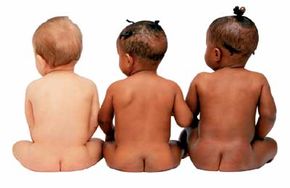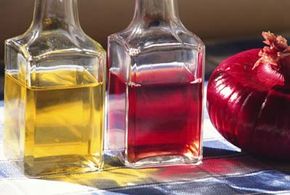The good news is, you can usually cure diaper rash within days. And with some conscientious care, you can say goodbye to it forever. The following home remedies can help you not only get rid of diaper rash but protect your baby's tender bottom from future bouts. Let's start with some basic tips:
Get rid of the diaper ... and say goodbye to diaper rash. The diaper holds the urine and/or feces against baby's sensitive skin and creates a warm, moist environment that can make the skin raw and provides the perfect breeding ground for bacteria, yeast, and fungus. To treat and/or prevent diaper rash, therefore, let your baby go bare-bottomed whenever possible. To minimize mess, put your diaperless baby on a rubber mat covered with a washable cloth.
Change the baby often. When going diaper-free isn't feasible, the best way to avoid diaper rash or cure an existing outbreak is to make sure the baby is always clean and dry. Check the baby's diaper often, and change it as soon as possible after it is soiled.
Avoid commercial baby wipes. Many brands of store-bought baby wipes contain alcohol and other chemicals that can irritate your child's skin and strip it of the natural protective oils that keep it soft and supple. Water, perhaps with a little mild soap, and a soft washcloth are actually the best tools for cleaning baby's bottom if you want to prevent a rash. If you do use soap, rinse thoroughly with a clean, wet cloth or plain water to remove any residue. You may want to skip the soap if a rash is already present, though, since it may cause stinging.
Dry that bottom. Once you've removed a soiled diaper and cleaned your baby's bottom, make sure you thoroughly pat the area dry (no rubbing!) with a soft towel. To ensure a completely dry bottom, leave the area exposed to air for a few minutes before putting on a new diaper.
Put on a barrier. Many pediatricians recommend applying a thin layer of nonprescription diaper-rash cream or ointment containing zinc oxide, such as A and D or Desitin, every time you change your baby. Used on healthy skin, it forms a barrier that can help protect the diaper area from the irritating effects of urine and feces. If a rash is already present, however, you don't want to completely seal the skin with an ointment or thick layer of cream, since air reaching the skin will keep the irritated area dry and help it heal. So you may need to either skip the salve until the skin clears or apply only a thin layer of cream, which will soothe and help protect the skin while allowing some air to penetrate.
Use only baby-friendly skin products. Choose soaps, shampoos, creams, and ointments specifically designed for use on baby's tender skin. Don't use products meant for adults, which often contain strong detergents, fragrances, dyes, and other chemicals that can irritate a baby's skin. Never use a cream that contains camphor, phenol, methyl salicylate, benzoin tincture, or boric acid on your baby unless specifically directed to by the pediatrician. Also, wash your infant's diapers, clothes, sleepwear, bedding, towels, and washcloths separately from those of other household members, using a laundry soap designed for this purpose. Residue of harsh detergents, bleaches, and fabric softeners on material that comes into prolonged contact with baby's skin may be enough to cause irritation.
Give powder a pass. In the past, the accepted way to keep a baby's bottom dry was to sprinkle talcum powder or cornstarch on the diaper area to soak up moisture. However, studies have shown that if babies inhale talcum powder, it can be dangerous, even fatal. And cornstarch or cornstarch-based powders foster the growth of yeast. So this is one old remedy to leave in the past.
Put the diapers "on line." Some moms have been taught that diapers are less likely to cause a rash if they are hung out to dry on a line instead of tossed into a dryer. Call it mother's intuition, but they may have something there: Some doctors say this trick works, although no one is sure why. If you have a place to hang diapers, you may want to give it a try. If you use a clothes dryer instead, skip the dryer sheets, which are likely to contain chemicals that can easily irritate sensitive baby skin. No matter how you dry cloth diapers, however, be sure to wash them in hot water without bleach and, if your baby already has diaper rash or seems prone to getting it, rinse them twice without adding fabric softener.
Try vinegar solution. Stale urine is extremely alkaline (the bacteria that colonize it release ammonia) and can burn the skin the same way acid can. To neutralize it, add half a cup of white vinegar to the rinse water when you wash the baby's diapers. If you use disposables, you can try wiping the baby's bottom with a solution of eight parts water to one part vinegar for a similar effect.
Avoid plastic pants. Diaper rash clears up faster when the skin remains dry. Plastic pants worn over a diaper, however, keep moisture in. If a rash is present, also avoid tight-fitting diapers and clothing, which may cause chafing as well as restrict air flow. You may even need to switch, at least temporarily, to looser or larger-size diapers if you usually use more-fitted diapers that have tight, elastic leg holes and other "leak guards" that hold in urine in and keep out air.
Try a different disposable. Some babies may be sensitive to materials or substances in one brand of disposable diaper but not in another. So if diligent changing of soiled diapers and other home remedies haven't completely cleared the rash or kept it from coming back, you might want to experiment with another brand to see if it does the trick.
The tips will surely keep baby's bottom free from irritation. If you need some additional tips for gentle relief, read on to learn the home remedies that are available in your very own kitchen.
For more information on the best ways to care for your newborn baby, try the following links:
This information is solely for informational purposes. IT IS NOT INTENDED TO PROVIDE MEDICAL ADVICE. Neither the Editors of Consumer Guide (R), Publications International, Ltd., the author nor publisher take responsibility for any possible consequences from any treatment, procedure, exercise, dietary modification, action or application of medication which results from reading or following the information contained in this information. The publication of this information does not constitute the practice of medicine, and this information does not replace the advice of your physician or other health care provider. Before undertaking any course of treatment, the reader must seek the advice of their physician or other health care provider.
The brand name products mentioned in this publication are trademarks or service marks of their respective companies. The mention of any product in this publication does not constitute an endorsement by the respective proprietors of Publications International, Ltd. or HowStuffWorks.com, nor does it constitute an endorsement by any of these companies that their products should be used in the manner described in this publication.

